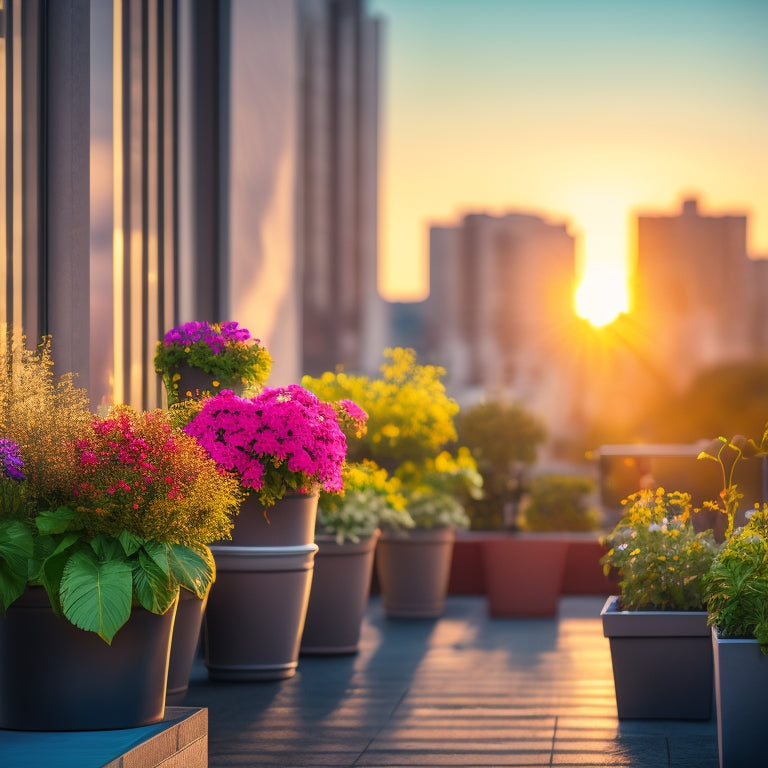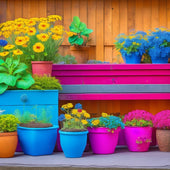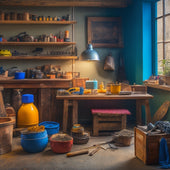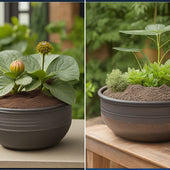
Urban Gardening Made Easy With Block Planters
Share
You can turn small urban spaces into thriving gardens with block planters, a versatile and accessible way to grow your own herbs, flowers, and vegetables. By choosing the right block type, designing a structurally sound planter, and selecting plants suited to your space, you'll be well on your way to a bountiful harvest. Don't forget to prepare your soil, maintain your plants, and stay informed about common mistakes to avoid. With these basics covered, you can start to get creative with your block garden, exploring different layouts, colors, and themes to make it truly your own - and that's just the beginning.
Key Takeaways
• Block planters offer a space-saving solution for urban gardening, allowing for maximum growth in small areas.
• Choose the right block type, considering factors like material, durability, and aesthetics, to ensure a thriving garden.
• Proper soil preparation, including pH testing and drainage solutions, is crucial for healthy plant growth in block gardens.
• Regular maintenance, including watering, pruning, and fertilizing, is necessary to maintain a successful block garden.
• Creative approaches, such as vertical gardening and color blocking, can enhance the aesthetic appeal of urban block gardens.
Cinder Block Garden Bed Design
Design a sturdy and stylish cinder block garden bed by arranging the blocks in a level, rectangular pattern, leaving space between each block for drainage and aeration.
This thoughtful design not only adds visual appeal to your outdoor space but also guarantees your plants receive the necessary air and water circulation.
As you plan your garden bed, consider the cinder block aesthetics you want to achieve. Will you opt for a uniform, symmetrical look or a more rustic, irregular pattern? Either way, the rectangular shape will provide a clean and modern feel.
When it comes to block drainage solutions, don't forget to leave about 1-2 inches of space between each block. This gap allows excess water to escape, preventing waterlogged soil and root rot.
You can also add a layer of gravel or crushed stone at the bottom of your bed for extra drainage.
By incorporating these design elements, you'll create a beautiful and functional cinder block garden bed that will thrive in your urban oasis.
With a little creativity and planning, you'll be enjoying fresh produce and a sense of community in no time!
Building a Block Planter Wall
As you expand your urban gardening project, you can now take your cinder block creations to new heights by building a block planter wall that not only adds a decorative element to your outdoor space but also increases your growing capacity.
This vertical gardening solution is perfect for small urban spaces, as it maximizes space while providing ample room for plants to thrive.
When building your block planter wall, start by laying a level foundation and then stacking the blocks, leaving space for soil and plants. You can add a trellis or other support system for climbing plants and incorporate irrigation and drainage systems for ideal growth.
The block planter benefits are numerous, including increased yields, improved air circulation, and enhanced block planter aesthetics. Plus, the modular design allows for easy expansion or rearrangement as your garden evolves.
With a block planter wall, you can create a stunning and functional outdoor space that showcases your urban gardening skills.
Choosing the Right Block Type
When choosing the right block type for your urban garden, you'll need to evaluate the material options that fit your needs and budget.
Will you opt for durable concrete, sustainable recycled plastic, or something else?
Block Material Options
You're faced with a variety of block materials to choose from, each with its unique benefits and drawbacks, so selecting the right type is vital to creating a thriving urban garden.
As you weigh your options, consider the block aesthetics that fit your personal style. Do you prefer the modern look of concrete blocks or the natural charm of wooden blocks?
Besides aesthetics, block durability is an important factor to guarantee your garden withstands the elements. Concrete blocks are incredibly durable and can support heavy loads, making them ideal for larger gardens. Wooden blocks, on the other hand, are more prone to rot and decay, but they can add a touch of warmth to your urban oasis.
If you're looking for a low-maintenance option, consider recycled plastic blocks, which are resistant to weathering and require minimal upkeep.
Whatever block material you choose, make sure it aligns with your gardening goals and personal preferences. By selecting the right block type, you'll be well on your way to creating a thriving urban garden that brings you joy and a sense of belonging.
Planter Size Selection
With your block material chosen, the next essential decision is determining the ideal planter size to bring your urban gardening vision to life.
You'll want to reflect on the mature size of your plants, as well as the space available in your urban garden. A general rule of thumb is to choose planters that are at least 6-8 inches deep to provide adequate room for root growth. However, if you're working with smaller plants or herbs, shallower planters may suffice.
When selecting your planter size, don't forget to think about optimal spacing techniques. You'll want to leave enough space between each planter for easy access and maintenance, as well as to prevent overcrowding. A good starting point is to leave at least 1-2 feet of space between each planter.
This will also allow for good air circulation and sunlight penetration. By choosing the right planter size, you'll be able to create a thriving and harmonious urban garden that brings you joy and a sense of community.
Preparing Soil for Block Gardens
Before filling your block planters, test the pH level of your soil to guarantee it's within the ideal range for your chosen plants, as block gardens can be more prone to pH imbalances.
You can use a DIY soil testing kit or send a sample to a lab for analysis. If your soil is too acidic or alkaline, you'll need to add soil amendments to adjust the pH. For instance, adding lime can raise the pH, while peat moss or sulfur can lower it.
Additionally, consider the drainage of your soil. Block gardens can be prone to waterlogging, which can lead to root rot and other problems.
To combat this, incorporate drainage solutions like perlite, vermiculite, or sand into your soil mix. These materials will help excess water drain away from the roots, ensuring healthy plant growth.
Selecting Plants for Block Gardens
As you choose plants for your block garden, consider the unique conditions of your urban space, including sunlight exposure, wind direction, and surrounding architecture, to select varieties that will thrive in this environment.
You'll want to think about the amount of direct sunlight your block garden receives, as well as any shade provided by nearby buildings. This will help you determine which plants will do best in your space.
When it comes to herb selection, consider varieties that are compact or dwarf, making them perfect for small spaces. Basil, mint, and cilantro are all great options for block gardens.
For flower varieties, look for those that are resistant to wind and can tolerate a range of sunlight conditions. Succulents and creeping thyme are great choices, as they're low-maintenance and can thrive in urban environments.
Don't be afraid to get creative and experiment with different combinations of plants to find what works best for your block garden. By choosing the right plants, you'll be well on your way to creating a thriving urban oasis.
Block Gardening Maintenance Tips
You'll need to commit to regular upkeep to keep your block garden thriving, and that means staying on top of watering, pruning, and fertilizing.
With block gardening, you'll reap the benefits of having a low-maintenance garden that still provides a bountiful harvest.
To keep your block garden in top shape, make sure to:
-
Water your plants when the top inch of soil feels dry to the touch
-
Prune any dead or dying leaves or stems to promote healthy growth and prevent the spread of disease
-
Fertilize your plants regularly with a balanced fertilizer to provide essential nutrients
Common Block Gardening Mistakes
Even with proper planning and maintenance, block gardeners often fall prey to common mistakes that can hinder the success of their garden.
You might be surprised to know that overwatering plants is a common error that can lead to root rot and other problems. Confirm to check the soil moisture before watering, and avoid watering in excess.
Another mistake is neglecting pest control. Failing to monitor your plants for signs of pests can lead to infestations that can quickly spread. Keep an eye out for signs of pests, and take action promptly if you notice any issues.
Additionally, you might be making the mistake of not providing enough air circulation around your plants. Good air circulation is essential for healthy plant growth, so confirm to leave enough space between your block planters.
Finally, not rotating your crops can lead to soil depletion and reduced yields. By rotating your crops, you can maintain soil health and prevent pests and diseases from building up.
Creative Block Planter Ideas
From modern architectural designs to whimsical DIY projects, block planters offer a versatile canvas for creative expression, letting you turn your urban gardening space into a unique reflection of your personal style. You can experiment with different block planter aesthetics to create a look that's all your own.
Here are some creative block planter ideas to get you started:
-
Vertical Gardening: Stack block planters to create a living wall that adds greenery to even the smallest of spaces. This is perfect for urban gardens where space is limited.
-
Color Blocking: Use block planters in different colors to create a visually appealing display. You can arrange them in a pattern or create a rainbow effect to add some fun to your garden.
-
Themed Planters: Create a themed garden by using block planters with a specific design or style. For example, you can use planters with a coastal vibe to create a beach-inspired garden.
Frequently Asked Questions
Can I Use Block Planters on a Balcony or Small Patio?
You're wondering if block planters can thrive on your balcony or small patio? Absolutely!
With a little balcony design savvy, you can turn even the tiniest space into a lush oasis.
Since small spaces can be challenging, choose planters that fit snugly, leaving enough room for air circulation and maintenance.
How Do I Prevent Weeds From Growing up Through the Blocks?
To prevent weeds from taking over your beautiful block planters, you'll want to prioritize weed prevention and regular block planter maintenance.
Start by lining the bottom of each block with a weed barrier, like landscape fabric or plastic sheeting.
Next, fill the block with a weed-free potting mix, and mulch the top to suppress any stray seeds.
Are Block Gardens Suitable for Growing Vegetables and Fruits?
You'll grow the juiciest tomatoes and crunchiest carrots the world has ever seen in a block garden!
But seriously, block gardens are incredibly suitable for growing a wide variety of vegetables and fruits.
You'll reap the block garden benefits of improved drainage, aeration, and soil structure, making it an ideal space for your favorite vegetable varieties to thrive.
Can I Move Block Planters to a New Location if Needed?
Can you relocate your block planters if needed? Absolutely! You can move them to a new spot, and they'll thrive as long as you plan ahead.
Make sure your planters are durable enough to withstand the shift, and don't forget to maintain the soil quality during the change.
With a little planning, you can easily relocate your block planters and enjoy a bountiful harvest in their new home.
Do Block Planters Require More Water Than Traditional Gardens?
You're wondering if block planters require more water than traditional gardens. The answer lies in their unique design.
Since block planters have built-in drainage solutions, you don't need to worry about overwatering. In fact, they often require less water due to their excellent moisture retention.
This means you'll use less water overall, making them a water-efficient option. With block planters, you can enjoy a thriving garden while conserving this precious resource.
Conclusion
As you tend to your thriving block garden, remember that it's a modern oasis, a verdant refuge from the urban jungle.
Like a Renaissance painter adding finishing touches to a masterpiece, you've carefully crafted each layer, from the foundation of cinder blocks to the vibrant blooms above.
Now, as you reap the fruits of your labor, take a moment to appreciate the beauty and bounty of your handiwork, a true demonstration of the power of urban gardening made easy with block planters.
Related Posts
-

10 Essential Steps to Upcycle Concrete Planters
You've decided to breathe new life into those old concrete planters lying around, and you're ready to transform them ...
-

10 Essential Steps to Upcycle Concrete Planters
You've decided to breathe new life into those old concrete planters lying around, and you're ready to transform them ...
-

10 Essential Steps to Upcycle Concrete Planters
You've decided to breathe new life into those old concrete planters lying around, and you're ready to transform them ...
-

10 Essential Steps to Upcycle Concrete Planters
You've decided to breathe new life into those old concrete planters lying around, and you're ready to transform them ...
-

10 Essential Steps to Upcycle Concrete Planters
You've decided to breathe new life into those old concrete planters lying around, and you're ready to transform them ...
-

10 Essential Steps to Upcycle Concrete Planters
You've decided to breathe new life into those old concrete planters lying around, and you're ready to transform them ...
-

10 Essential Steps to Upcycle Concrete Planters
You've decided to breathe new life into those old concrete planters lying around, and you're ready to transform them ...
-

10 Essential Steps to Upcycle Concrete Planters
You've decided to breathe new life into those old concrete planters lying around, and you're ready to transform them ...
-

10 Essential Steps to Upcycle Concrete Planters
You've decided to breathe new life into those old concrete planters lying around, and you're ready to transform them ...
-

10 Essential Steps to Upcycle Concrete Planters
You've decided to breathe new life into those old concrete planters lying around, and you're ready to transform them ...
-

10 Essential Steps to Upcycle Concrete Planters
You've decided to breathe new life into those old concrete planters lying around, and you're ready to transform them ...
-

10 Essential Steps to Upcycle Concrete Planters
You've decided to breathe new life into those old concrete planters lying around, and you're ready to transform them ...
-

10 Essential Steps to Upcycle Concrete Planters
You've decided to breathe new life into those old concrete planters lying around, and you're ready to transform them ...
-

10 Essential Steps to Upcycle Concrete Planters
You've decided to breathe new life into those old concrete planters lying around, and you're ready to transform them ...
-

10 Essential Steps to Upcycle Concrete Planters
You've decided to breathe new life into those old concrete planters lying around, and you're ready to transform them ...
-

10 Essential Steps to Upcycle Concrete Planters
You've decided to breathe new life into those old concrete planters lying around, and you're ready to transform them ...
-

10 Essential Steps to Upcycle Concrete Planters
You've decided to breathe new life into those old concrete planters lying around, and you're ready to transform them ...
-

10 Essential Steps to Upcycle Concrete Planters
You've decided to breathe new life into those old concrete planters lying around, and you're ready to transform them ...
-

10 Essential Steps to Upcycle Concrete Planters
You've decided to breathe new life into those old concrete planters lying around, and you're ready to transform them ...
-

10 Essential Steps to Upcycle Concrete Planters
You've decided to breathe new life into those old concrete planters lying around, and you're ready to transform them ...
-

10 Essential Steps to Upcycle Concrete Planters
You've decided to breathe new life into those old concrete planters lying around, and you're ready to transform them ...
-

10 Essential Steps to Upcycle Concrete Planters
You've decided to breathe new life into those old concrete planters lying around, and you're ready to transform them ...
-

10 Essential Steps to Upcycle Concrete Planters
You've decided to breathe new life into those old concrete planters lying around, and you're ready to transform them ...
-

10 Essential Steps to Upcycle Concrete Planters
You've decided to breathe new life into those old concrete planters lying around, and you're ready to transform them ...
-

10 Essential Steps to Upcycle Concrete Planters
You've decided to breathe new life into those old concrete planters lying around, and you're ready to transform them ...
-

10 Essential Steps to Upcycle Concrete Planters
You've decided to breathe new life into those old concrete planters lying around, and you're ready to transform them ...
-

10 Essential Steps to Upcycle Concrete Planters
You've decided to breathe new life into those old concrete planters lying around, and you're ready to transform them ...
-

10 Essential Steps to Upcycle Concrete Planters
You've decided to breathe new life into those old concrete planters lying around, and you're ready to transform them ...
-

10 Essential Steps to Upcycle Concrete Planters
You've decided to breathe new life into those old concrete planters lying around, and you're ready to transform them ...
-

3 Best Tool Essentials for Creative Concrete Planters
To create visually stunning and durable concrete planters, you'll need three essential tool categories. First, you'll...
-

3 Best Tool Essentials for Creative Concrete Planters
To create visually stunning and durable concrete planters, you'll need three essential tool categories. First, you'll...
-

3 Best Tool Essentials for Creative Concrete Planters
To create visually stunning and durable concrete planters, you'll need three essential tool categories. First, you'll...
-

3 Best Tool Essentials for Creative Concrete Planters
To create visually stunning and durable concrete planters, you'll need three essential tool categories. First, you'll...
-

3 Best Tool Essentials for Creative Concrete Planters
To create visually stunning and durable concrete planters, you'll need three essential tool categories. First, you'll...
-

3 Best Tool Essentials for Creative Concrete Planters
To create visually stunning and durable concrete planters, you'll need three essential tool categories. First, you'll...
-

3 Best Tool Essentials for Creative Concrete Planters
To create visually stunning and durable concrete planters, you'll need three essential tool categories. First, you'll...
-

3 Best Tool Essentials for Creative Concrete Planters
To create visually stunning and durable concrete planters, you'll need three essential tool categories. First, you'll...
-

3 Best Tool Essentials for Creative Concrete Planters
To create visually stunning and durable concrete planters, you'll need three essential tool categories. First, you'll...
-

3 Best Tool Essentials for Creative Concrete Planters
To create visually stunning and durable concrete planters, you'll need three essential tool categories. First, you'll...
-

3 Best Tool Essentials for Creative Concrete Planters
To create visually stunning and durable concrete planters, you'll need three essential tool categories. First, you'll...
-

3 Best Tool Essentials for Creative Concrete Planters
To create visually stunning and durable concrete planters, you'll need three essential tool categories. First, you'll...
-

3 Best Tool Essentials for Creative Concrete Planters
To create visually stunning and durable concrete planters, you'll need three essential tool categories. First, you'll...
-

3 Best Tool Essentials for Creative Concrete Planters
To create visually stunning and durable concrete planters, you'll need three essential tool categories. First, you'll...
-

What Depth Is Best for My Planter
When selecting a planter, consider the root depth requirements of your chosen plant species, as this dictates the min...
-

What Depth Is Best for My Planter
When selecting a planter, consider the root depth requirements of your chosen plant species, as this dictates the min...
-

What Depth Is Best for My Planter
When selecting a planter, consider the root depth requirements of your chosen plant species, as this dictates the min...
-

What Depth Is Best for My Planter
When selecting a planter, consider the root depth requirements of your chosen plant species, as this dictates the min...
-

What Depth Is Best for My Planter
When selecting a planter, consider the root depth requirements of your chosen plant species, as this dictates the min...
-

What Depth Is Best for My Planter
When selecting a planter, consider the root depth requirements of your chosen plant species, as this dictates the min...
-

What Depth Is Best for My Planter
When selecting a planter, consider the root depth requirements of your chosen plant species, as this dictates the min...
-

What Depth Is Best for My Planter
When selecting a planter, consider the root depth requirements of your chosen plant species, as this dictates the min...
-

What Depth Is Best for My Planter
When selecting a planter, consider the root depth requirements of your chosen plant species, as this dictates the min...
-

What Depth Is Best for My Planter
When selecting a planter, consider the root depth requirements of your chosen plant species, as this dictates the min...
-

What Depth Is Best for My Planter
When selecting a planter, consider the root depth requirements of your chosen plant species, as this dictates the min...
-

What Depth Is Best for My Planter
When selecting a planter, consider the root depth requirements of your chosen plant species, as this dictates the min...
-

What Depth Is Best for My Planter
When selecting a planter, consider the root depth requirements of your chosen plant species, as this dictates the min...
-

What Depth Is Best for My Planter
When selecting a planter, consider the root depth requirements of your chosen plant species, as this dictates the min...
-

What Depth Is Best for My Planter
When selecting a planter, consider the root depth requirements of your chosen plant species, as this dictates the min...
-

What Depth Is Best for My Planter
When selecting a planter, consider the root depth requirements of your chosen plant species, as this dictates the min...
-

What Depth Is Best for My Planter
When selecting a planter, consider the root depth requirements of your chosen plant species, as this dictates the min...
-

What Depth Is Best for My Planter
When selecting a planter, consider the root depth requirements of your chosen plant species, as this dictates the min...
-

What Depth Is Best for My Planter
When selecting a planter, consider the root depth requirements of your chosen plant species, as this dictates the min...
-

What Depth Is Best for My Planter
When selecting a planter, consider the root depth requirements of your chosen plant species, as this dictates the min...
-

What Depth Is Best for My Planter
When selecting a planter, consider the root depth requirements of your chosen plant species, as this dictates the min...


